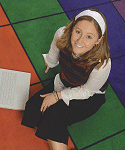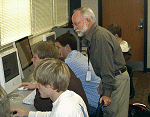THE Journal's 2008 Innovators :: 3
Melissa Walker
Alamance-Burlington School System (NC)
 When Melissa Walker was
finishing up her coursework
at the School of Education at
North Carolina's Elon University,
her professors would
tell her to make the most of
her student teaching. "Try to
check out the technology
cart," they would advise, "or
integrate
computers into lessons." So she was shocked
when her "cooperating," or host, teacher
couldn't tell her how to check out the technology
cart. "She was a phenomenal teacher,
but she was missing something," says Walker.
"That was the integration of technology."
When Melissa Walker was
finishing up her coursework
at the School of Education at
North Carolina's Elon University,
her professors would
tell her to make the most of
her student teaching. "Try to
check out the technology
cart," they would advise, "or
integrate
computers into lessons." So she was shocked
when her "cooperating," or host, teacher
couldn't tell her how to check out the technology
cart. "She was a phenomenal teacher,
but she was missing something," says Walker.
"That was the integration of technology."
Months later, in fall 2005, she joined the
Alamance-Burlington School System in
Burlington, NC, as a fifth-grader teacher,
intent on using technology to benefit her
students. By the time she was promoted to
lead teacher of K-8 technology integration
for the district last January, Walker was
determined to break down whatever barriers
were hindering the use of classroom technology,
whether a lack of support for new teachers
or a lack of understanding among veteran
ones. She identified a huge chasm between
the availability of technology and teachers'
willingness to use it. For example, Walker
found that even though many classrooms had Smart Boards, they
were being used, she says, like "very expensive
regular whiteboards."
The district leadership recognized the
need to foster classroom technology use
with professional development, but didn't
have the resources to make it happen.
"Being in charge of 20 elementary schools,
I couldn't be in every classroom every day
and give support to those teachers," Walker
says. So she reached out to two of her former
Elon professors-- Judith Howard and
Barbara Taylor-- with an idea for a partnership
with the district, where Elon places
most of its student teachers.
The three women formed a plan whereby
the university's education students would
get classroom experience teaching with new
technologies while their cooperating teachers
observed how those devices could be
integrated into lessons. Walker would teach a one-time, 90-
minute session on technology integration to a class of Elon
junior education majors who were getting their introduction to
classroom teaching, instructing them on how to teach with
tools such as interactive whiteboards and iPods. She also
offered to consult with the students regularly on the development
of tech-infused lessons that they could then teach in their
Almance-Burlington classrooms as their cooperating teachers
looked on.
The program has been very well received. Veteran teachers
have told Walker that by observing the Elon students working
with their kids, they have seen technology's power to spark
learning. At the end of one lesson, a host teacher approached the student teacher in tears because of the transformation she
saw in one child. "The Elon student had reached him like no
one had ever done before," says Walker. "That was the first
time he had ever actively participated in class. At that moment,
I knew what we were doing was so important."
Randy Orwin
Bainbridge Island School District (WA)
 When Bainbridge Island, WA, passed a levy in 2006 that covered
the purchase of new laptops for its school district, it didn't
provide for software or training. That end of it would have to
come out of the Bainbridge Island School District IT budget,
which runs about $108,000 a year, not including salaries. Yet
when Randy Orwin, director of technology, looked into upgrading
the new machines with Microsoft Office 2003, the bill would
have run between $40,000 and $60,000 a year for a subscription
plan, or $140,000 to buy the software outright-- an investment
that would have meant cutting other services such as the district's
content filter or its
firewall. "We had to find an
alternative," says Orwin.
Orwin looked into using
open source OpenOffice
software and was confident
it would be a worthwhile--
and free-- alternative to
Microsoft Office. He made
a presentation to the district's
technical advisory
and leadership groups,
proposing that Bainbridge
migrate to open source software and use the resulting savings
for training staff and teachers on the new technologies it was
about to introduce.
When Bainbridge Island, WA, passed a levy in 2006 that covered
the purchase of new laptops for its school district, it didn't
provide for software or training. That end of it would have to
come out of the Bainbridge Island School District IT budget,
which runs about $108,000 a year, not including salaries. Yet
when Randy Orwin, director of technology, looked into upgrading
the new machines with Microsoft Office 2003, the bill would
have run between $40,000 and $60,000 a year for a subscription
plan, or $140,000 to buy the software outright-- an investment
that would have meant cutting other services such as the district's
content filter or its
firewall. "We had to find an
alternative," says Orwin.
Orwin looked into using
open source OpenOffice
software and was confident
it would be a worthwhile--
and free-- alternative to
Microsoft Office. He made
a presentation to the district's
technical advisory
and leadership groups,
proposing that Bainbridge
migrate to open source software and use the resulting savings
for training staff and teachers on the new technologies it was
about to introduce.
Orwin's proposal was approved, and in the summer of 2007,
under his direction, the IT team distributed the new laptops to
the 300 teachers in the district. First, the teachers had to attend
a six-hour "boot camp" that trained them on how to use their
machines. By the end of the day, they were educated in the basics
of OpenOffice and other open source applications included on
the computers, such as GIMP, an image-editing program;
Stellarium, planetarium software; and Audacity, software for recording
and editing audio. Also, during the past two summers, Orwin
has run two-week-long institutes during which district teachers
and staff were trained on core functions such as mail merge,
spreadsheets, presentations, and even opening documents.
Bainbridge has also been able to expand its Moodle implementation, which it originally rolled
out in 2005. "We started with eight or 10 teachers using it with
a few courses," says Orwin. "Right now, we have 3,800 people
on our Moodle server and just slightly more than 300 Moodle
sites." The open source course management system is used by
teachers to create websites for their classes; students to do class
blogging; committees to maintain work, share documents, and
communicate; and administrators to register people for training.
Orwin estimates that the money saved by using open source
applications has totaled $50,000 to $60,000 a year, "every
penny of which has gone into training," he says. Although the
cost savings have been a major gain for the district, according
to Orwin, the benefits of migrating to open source software
reach beyond the budget. "The power of open source is that you
become part of a community where everybody is in it to help
each other," he explains. "It's great software. It runs like it's
supposed to and it's every bit as good as commercial software."
John Barnes
Jessamine Career and Technology Center (KY)

Barnes hopes computer
visualization will improve
his students' math skills.
After 32 years of teaching students in Jessamine County
Schools, John Barnes is still fascinated by how kids learn,
particularly in the area of math. "You always have students
who are good in algebra or good in geometry-- and sometimes
in both, but rarely," he says. "Why is that?"
A move to the newly created Jessamine Career and
Technology Center gave Barnes, who teaches advanced calculus
as well as IT, a chance to test his theory that success in
math boils down to the ability to visualize things in three
dimensions. In spring 2007, during the first year the school
was in operation, Barnes worked with Joan Mazur, associate
professor of curriculum and instruction at the University of
Kentuckyin nearby Lexington, on the development of a nineweek
experimental course in computer visualization.
The university's Center for Visualization and Visual Environments,
where Mazur works, bought the school a year's
worth of licenses to the pricey Autodesk 3ds Max, which does modeling, animation, and rendering.
The application was chosen specifically, says Barnes,
because it's used by researchers at the center and has become
an industry standard. Grant money continued the licensing
and covered the purchase of high-end Apple iMacs and additional
RAM for the computers to support the hefty hardware
requirements of the program.
Student enthusiasm for the course-- held early in the morning,
before the regular classes-- led the school, which draws students
from both East and West Jessamine high schools, to add
computer visualization to its permanent curriculum.
Each of the mostly juniors and seniors in the class-- "Every
once in a while we get a ninth-grader," Barnes says-- works at a
computer that's loaded with 3ds Max as well as Adobe Photoshop. One modeling project Barnes
assigns requires the creation of a World War II plane from the
views provided on plane spotter cards-- cards showing front,
bottom, and side views used by US military personnel during
the war to identify what was flying overhead. "We take those
three views and put them into Photoshop, then copy and paste
and use those views...in 3ds Max to begin modeling that type of
airplane," Barnes explains. "Then I pair students to model their
airplanes flying together."
But the biggest project yet is ongoing: the creation of a
model of the school itself. "We can move the ‘camera' through
the building, up the steps, down the hall, go into a room, and
render that as a movie," says Barnes. Each semester the class
will add more rooms, "until we have the entire building
included in our virtual tour."
Barnes doesn't know what impact learning computer visualization
will have, but he does have a hope: that students who have
had trouble in math will do better after taking his classes. "As a
teacher, you never really know what's going to happen," he says.
"Sometimes you see the fruits of your work 10 or 12 years later."